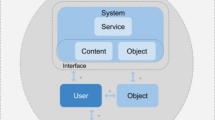Abstract
We are aware already that the world is facing a milestone. The transitions to the millennium’s second decade are forcing transformative agents to embrace new perspectives. Spotting that design is a powerful change agent, design practitioners search for different-novel approaches to learn from humankind’s missteps. Some of those “mistakes” are systematically ignored or discriminated against, affecting a large world’s population sectors. A visible consequence is a technological gap in people with disabilities, the elderly population, and indigenous communities. An observation on the potential non-typical smart products and service systems’ users promotes evolution in design processes during this research. This potential might reduce the technological gap for some users’ types, often considered as an outlier.
Access this chapter
Tax calculation will be finalised at checkout
Purchases are for personal use only
Similar content being viewed by others
References
Alvarez Icaza, I., Molina, A., Bustamante-Bello, R.: Connected platforms for the non-typical user: design methodology to observe the outliers. I. J. Comput. Commun. Eng. 9(3), 122–133 (2020)
Chavarría-Barrientos, D., Camarinha-Matos, L.M., Molina, A.: Achieving the sensing, smart and sustainable ‘everything.’ Int. J. Appl. Eng. Res. 10(13), 33694–33695 (2015)
Weichhart, G., Molina, A., Chen, D., Whitman, L.E.: Challenges and current developments for sensing, smart and sustainable enterprise systems. Comput. Ind. 79, 34–46 (2016)
Ponce, P., Meier, A., Miranda, J., Molina, A., Peffer, T.: The next generation of social products based on sensing, smart and sustainable (S3) features: a smart thermostat as case study. IFAC-PapersOnLine 52(13), 2390–2395 (2019)
Tomiyama, T., Lutters, E., Stark, R., Abramovici, M.: Development capabilities for smart products. CIRP Ann. 68(2), 727–750 (2019)
Navarro Tuch, S.A.: Emotional Domotics: acquisition of an equation for the correlation of emotional states and environmental variables through the facial expressions analysis of the user. Instituto Tecnológico y de Estudios Superiores de Monterrey (2018)
Irizar-Arrieta, A., Casado-Mansilla, D.: Coping with user diversity: UX informs the design of a digital interface that. In: Computer Science and Information Systems 11th Multi Conference (2017)
Ceccacci, S., Generosi, A., Giraldi, L., Mengoni, M.: An user-centered approach to design smart systems for people with dementia. In: IEEE International Conference on Consumer Electronics, Berlin, ICCE-Berlin, September 2017, pp. 273–278 (2017)
Cong, J.c., Chen, C.H., Zheng, P., Li, X., Wang, Z.: A holistic relook at engineering design methodologies for smart product-service systems development. J. Clean. Prod. 272, 122737 (2020)
Nam, S.J., Park, E.Y.: The effects of the smart environment on the information divide experienced by people with disabilities. Disabil. Health J. 10, 257–263 (2017)
Porter, M.E., Heppelmann, J.E.: How smart, connected products are transforming competition. (Spotlight on managing the Internet of Things). Harv. Bus. Rev. 92(11), 64 (2014)
Brena, R.F., Garcia-Ceja, E.: A crowdsourcing approach for personalization in human activities recognition. Intell. Data Anal. 21(3), 721–738 (2017)
Dubberly, H.: How do you design? A compendium of models (2005)
Ulrich, K.T.: Design is everything? J. Prod. Innov. Manag. 28(3), 394–398 (2011)
Bobbe, T., Krzywinski, J., Woelfel, C.: A comparison of design process models form academic theory and professional practice. In: International Design Conference, pp. 1205–1214 (2016)
Wang, Z.: Research on design method of intelligent service system in product processing under PSS concept. Procedia CIRP 83, 705–709 (2019)
Bhardwaj, A., Kolay, S.: Elderly friendly visual communication design: a user-centric approach for guideline formulation. In: Chakrabarti, A. (ed.) Research into Design for a Connected World. SIST, vol. 135, pp. 519–528. Springer, Singapore (2019). https://doi.org/10.1007/978-981-13-5977-4_44
Balaji, S.: Waterfall vs. V-model vs. agile: a comparative study on SDLC. Int. J. Inf. Technol. Bus. Manag. 2(1), 26–30 (2012)
Nielsen, J.: How to Conduct a Heuristic Evaluation (2007)
Fontenele, R.M., Sousa, A.I., Rasche, A.S., do Nascimento Souza, M.H., de Medeiros, D.C.: Participative construction and validation of the logical model of the School Health Program. Saúde em Debate 41, 167–179 (2017)
Wallisch, A., Pérez-Villalobos, C., Briedewestermeyer, J.C., Paetzold, K.: Bridging the gap – a co-creation experience of novice designers and elderly users. In: Proceedings of the 21st International Conference on Engineering and Product Design Education: Towards a New Innovation Landscape, E PDE 2019, September 2019
Acknowledgment
The authors acknowledge the technical support of Writing Lab, TecLabs, Tecnologico de Monterrey, Mexico, in the production of this work.
Author information
Authors and Affiliations
Corresponding author
Editor information
Editors and Affiliations
Rights and permissions
Copyright information
© 2021 The Author(s), under exclusive license to Springer Nature Switzerland AG
About this paper
Cite this paper
Alvarez-Icaza Longoria, I., Molina, A., Bustamante-Bello, R. (2021). Smart and Connected Systems for the Non-typical User: Design Methodology to Observe the Outliers. In: Shin, C.S., Di Bucchianico, G., Fukuda, S., Ghim , YG., Montagna, G., Carvalho, C. (eds) Advances in Industrial Design. AHFE 2021. Lecture Notes in Networks and Systems, vol 260. Springer, Cham. https://doi.org/10.1007/978-3-030-80829-7_31
Download citation
DOI: https://doi.org/10.1007/978-3-030-80829-7_31
Published:
Publisher Name: Springer, Cham
Print ISBN: 978-3-030-80828-0
Online ISBN: 978-3-030-80829-7
eBook Packages: EngineeringEngineering (R0)



